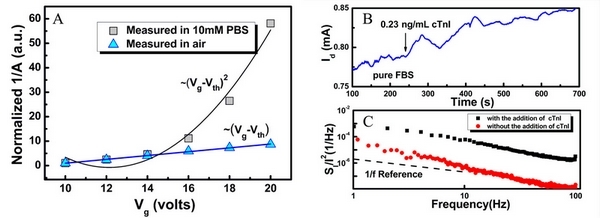Biosensors are able to convert a variety of biochemical reactions into measurable electrical, optical and other signals. Nano-device design, sensing strategy, timely response capability and manufacturability present core research value and application prospects.
Recently, Prof. CHENG Guosheng’s group from Suzhou Institute of Nano-Tech and Nano-bionics (SINANO), CAS successfully fabricated a label-free biosensor with FET configuration for an electrical detection of cardiac troponin I (cTnI) protein, golden biomarker of acute myocardial infarction (AMI), in a fasion of high sensitivity, selectivity, rapid response. The FET devices were fabricated by a CMOS compatible top-down approach to define the SiNW. Surface functionalization of nanomaterials is of great importance. The researchers have explored the surface modification strategies in their previous work (Langmuir 26, 4514–4522, 2010; Langmuir 27, 13220–13225, 2011). Herein, cTnI monoclonal antibodies were covalently immobilized on the SiNW surfaces. By integrating with a homemade biosensor measurement system, the biosensor exhibited rapid and sensitive response to cTnI proteins. The current response showed a nature of logarithm relationship against the cTnI concentration from 46 ng/mL down to 0.092 ng/mL. This work has been published on Biosensors and Bioelectronics (34, 267-272, 2012).
Furthermore, by employing low frequency noise spectroscopy analysis, the researchers demonstrated a new approach for highly sensitive bio-detection based on Si nanowire FETs. The inverse of noise amplitude of the device exhibited an enhanced gate coupling effect in strong inversion regime when measured in buffer solution than that in air. The approach was further validated by the detection of cardiac troponin I of 0.23 ng/ml in fetal bovine serum, in which 2 orders of change in noise amplitude was characterized. This work has been published on Applied Physics Letters (101, 093704, 2012), which provides new strategy for high performance biosensor designs.
This work was partially funded by “100 Talents Program” of CAS, National Natural Science Foundation of China, National Basic Research Program of China (973 Program). The professional services from Platforms for Characterization & Test and Nanofabrication Facility of SINANO also made the preceding work possible.
 |
|
Figure 1. Optical image of the fabricated SiNW FET arrays(A), SEM image of a single SiNW (B), Typical cTnI protein sensing result (C). |
 |
|
Figure 2. Comparison of normalized inverse noise amplitude of the same device at different Vgin air and in buffer (A), The current response of detection of cTnI protein (B) Normalized drain current noise power spectral density of the same device before and after the addition of cTnI (C). |
downloadFile
